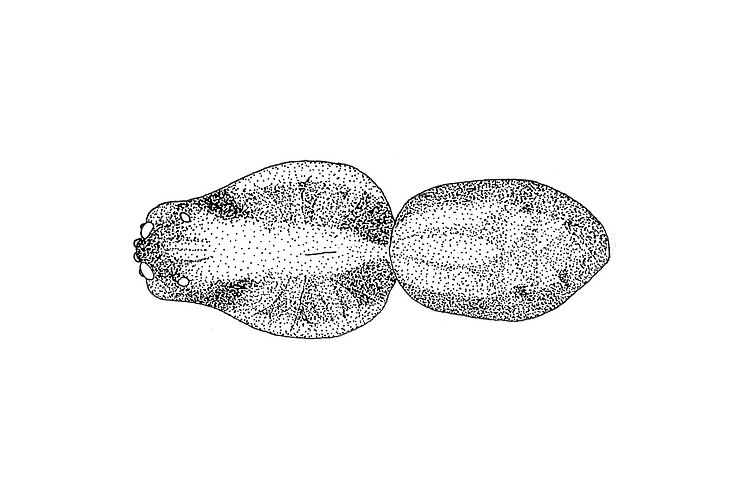Ornate Huntress Venatrix ornatula (L. Koch, 1877)
Fauna Portal species: 7782Status
- native
Linnean Syntype(s)
Australia
- New South Wales
- Queensland
Appearance
(after Framenau & Vink 2001): This small species can be confused only with Venatrix brisbanae, but is darker overall. The caput flanks and the posterior margin of the carapace are distinctly darker. Males are distinguished from V. brisbanae by the tegular apophysis of the pedipalp, which consists of one single part and its mesoapical edge is folded ventrally. The tegular apophysis of V. brisbanae consists of two distinct processes. Males do not have a tubercle on the outer curve of their fangs. The epigyne of the female is distinctive, as the median septum is very wide and hardly sclerotised.
Fauna Portal Records
The map shows all records that have been verified as part of the Fauna Portal project and may not represent the true distribution of a species. Specifically, for described species, check the link to the Atlas of Living Australia on this page for potential wider distributions. Fauna Portal Reference specimens and Linnean types are shown in red. If you identified a specimen that exceeds the distribution of an undescribed species as illustrated here, please contact the Fauna Portal team who can assist with the lodgement of the specimen in a public institution and display on the map.
Publications
Framenau VW (2006): The wolf spider genus Venatrix Roewer: new species, synonymies and generic transfers (Araneae, Lycosidae). Records of the Western Australian Museum. 23: 145 - 166WEB
Framenau VW, Vink CJ (2001): Revision of the wolf spider genus Venatrix Roewer (Araneae:Lycosidae). Invertebrate Taxonomy. 15: 927 - 970
Araneae (Spiders)
- Actinopodidae
- Anamidae
- Araneae fam. indet.
- Araneidae
- Archaeidae
- Argyronetidae
- Arkyidae
- Barychelidae
- Cheiracanthiidae
- Clubionidae
- Corinnidae
- Cycloctenidae
- Deinopidae
- Desidae
- Dictynidae
- Filistatidae
- Gnaphosidae
- Halonoproctidae
- Hersiliidae
- Idiopidae
- Lamponidae
- Linyphiidae
- Lycosidae
- Allotrochosina
- Anomalosa
- Artoria
- Artoriopsis
- Costacosa
- Diahogna
- Dingosa
- Genus 2556 (ariadnae grp)
- Genus 3448 (leonhardii gp)
- Genus 3491 (laeta grp)
- Genus 3643 (yalkara grp)
- Hoggicosa
- Hogna
- Kangarosa
- Knoelle
- Kochosa
- Lycosidae gen. indet.
- Mainosa
- Portacosa
- Tapetosa
- Tasmanicosa
- Tetralycosa
- Tuberculosa
- Venator
- Venatrix
- Venonia
- Zoica
- Allotrochosina
- Mimetidae
- Miturgidae
- Mysmenidae
- Nicodamidae
- Oecobiidae
- Oonopidae
- Oxyopidae
- Philodromidae
- Pholcidae
- Pisauridae
- Prodidomidae
- Salticidae
- Scytodidae
- Segestriidae
- Selenopidae
- Sparassidae
- Symphytognathidae
- Tetrablemmidae
- Tetragnathidae
- Theridiidae
- Thomisidae
- Trachelidae
- Trachycosmidae
- Trochanteriidae
- Uloboridae
- Zodariidae
- Zoropsidae
All classes
- Arachnida
- Crustacea
- Entognatha
- Gastropoda
- Insecta
- Orthoptera - Caelifera (Grasshoppers)
- Hymenoptera excl. Formicidae (bees and wasps)
- Blattodea s. str. (Cockroaches)
- Coleoptera (Beetles)
- Dermaptera (earwigs)
- Diptera (flies, mosquitos)
- Entomobryomorpha (slender springtails)
- Hemiptera - Heteroptera (True Bugs)
- Hemiptera - Sternorrhyncha (aphids, scales etc.)
- Hemiptera - Auchenorrhyncha (cicadas, planthoppers)
- Hymenoptera - Formicidae (Ants)
- Trichoptera (Caddisflies)
- Zygentoma (silverfish)
- Myriapoda

